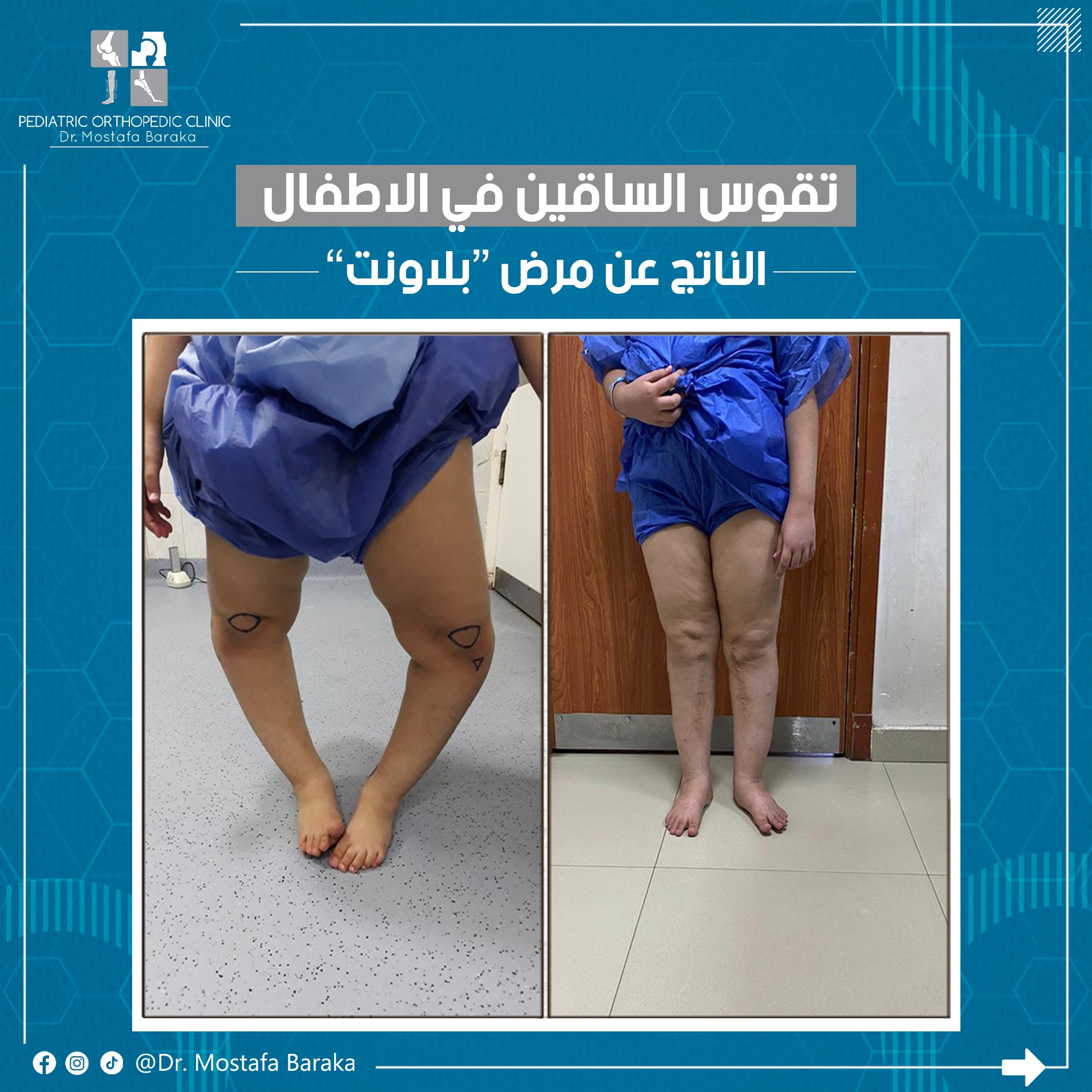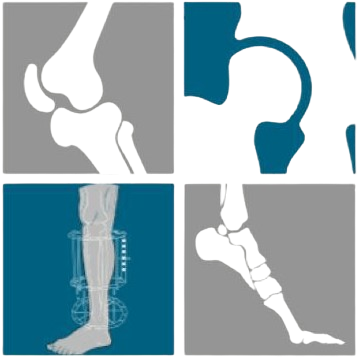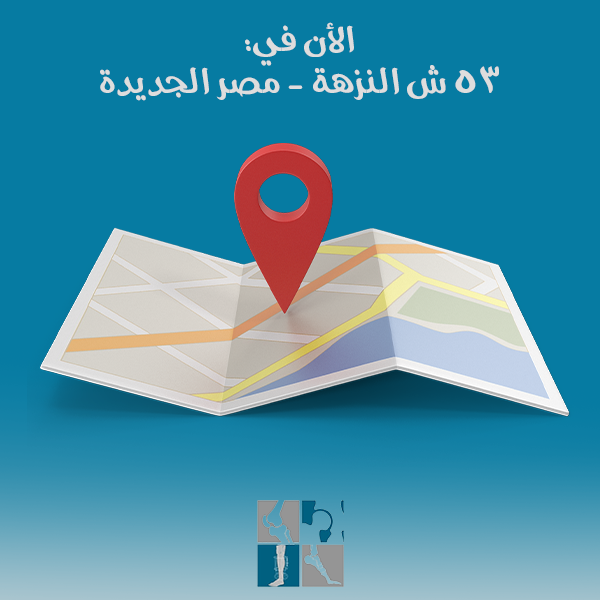- Address
- Call Us +20103281119
- home,email mostafa.baraka@hotmail.com
Bowed legs in children caused by Blount's disease

Bowed legs in children caused by Blount's disease
Diagnosis of bowed legs in children
Diagnosis of bow legs in children is usually made by orthopedic doctors and medical doctors who have experience diagnosing and treating bone and joint problems. Diagnosis includes evaluating the position and movement of the legs and studying the accompanying symptoms. An x-ray may be requested to confirm the presence of curvature in the legs and measure the angle of curvature.
What is Blount's disease?
Blount's disease is a common disorder that affects the legs in children. This disease is characterized by deformity of the upper leg area, causing abnormal curvature of the legs. This disease usually begins around the age of two or three and may progress over time if it is not treated. Children with Blount's disease may need early treatment to improve their posture and motor functions.
Symptoms of bowed legs resulting from Blount's disease
Symptoms of bow legs resulting from Blount's disease include deformity of the upper leg and an abnormal curvature. The legs may be unequal in length and thickness. This may be accompanied by certain pain in the joints and muscles, and difficulty moving and walking properly. It is important that Blount's disease is diagnosed and treated early to improve these symptoms and enhance the child's mobility.
Risk factors and psychological influences
There are many risk factors for Blount's disease in children, including genetic factors and natural factors such as unbalanced development of muscles and bones. Children with bow legs may be affected by negative psychological effects, as they feel embarrassed by their abnormal way of walking and have difficulty participating in sports activities with their peers. It is important that these children are supported and provided with psychological support and encouragement to enhance their self-confidence.
What factors cause Blount's disease in children?
Among the factors that cause Blount's disease in children are genetic factors. They may have a family history of the disease. Other factors that cause bowed legs include lack of balanced development of muscles and bones in the body. Lack of regular physical activity and spending a long time in a sitting position may also cause this deformity in the legs.
The effects of bowed legs on the psychological state of children
Bow legs can affect children's psychological state because it can lead to their shyness and lack of self-confidence. They may feel discriminated against and bullied by peers because of the visible deformity of their legs. They may feel embarrassed when dressing or doing physical activities. Children with bow legs may need psychological support and encouragement to deal with these negative psychological effects.
Common treatment methods
Common treatment methods for bow legs include regular monitoring and leg straightening. Early detection and continuous monitoring of the condition leads to a better chance of successful treatment. A leg splint may be used to correct the deformity and prevent its progression. Common treatment can help improve the appearance and function of the legs and reduce the psychosocial problems children may face.
Treating bowed legs through regular monitoring
Treating bowed legs with regular monitoring requires periodic monitoring of the condition and checking the development of the deformity. This helps in detecting early problems and taking appropriate action. Treatment may include monitoring muscle development in the legs and evaluating function and movement. Specialized doctors should be consulted to direct appropriate treatment and monitor the progress of the condition.
Splints or leg straightening are a common treatment
Leg splints are one of the common methods for treating bowed legs in children. A splint is used to guide and correct the legs during the growth phase. It works by applying mild force to the bones and joints in the legs to guide them into the correct position. It may take several years to wear a splint to get the desired results. It is recommended to consult with a specialist doctor before using a splint as a treatment for bowed legs.
Surgical procedures
Surgical procedures are one of the options that can be taken to treat bow legs in children. These procedures are performed by performing surgery to straighten the legs and correct deformities. The surgical procedure requires a long period of rest and rehabilitation after the operation. Surgical procedures should be performed under the supervision of a specialist doctor and after careful evaluation of the child's condition and health conditions.
Leg straightening surgery for children
Leg straightening is a surgical procedure used to treat bowed legs in children. An orthopedic surgeon performs the procedure to correct deformities caused by bowed legs. Children who undergo this procedure require a long period of rest and rehabilitation after surgery. This process is carried out under the supervision of a specialist doctor according to the assessment of the child’s condition and health conditions.
Rehabilitation after leg straightening surgery
بعد إجراء جراحة تقويم الساقين، يحتاج الطفل إلى فترة من إعادة التأهيل لتعافيه بشكل صحيح. يتضمن برنامج إعادة التأهيل عادةً جلسات العلاج الطبيعي والتمارين الخاصة بتقوية الساقين وتحسين التوازن. يتعاون فريق الرعاية الصحية مع الطفل وأسرته لضمان التقدم السليم في عملية التأهيل واستعادة القدرة على المشي بشكل طبيعي. يجب على الأهل اتباع التعليمات المقدمة من الفريق الطبي وضمان نجاح عملية التأهيل.
الوقاية والرعاية المنزلية
بعد إجراء جراحة تقويم الساقين للأطفال، هناك بعض الإجراءات التي يمكن اتخاذها في المنزل للوقاية من أي مضاعفات والعناية بالطفل بشكل صحيح. يجب تقديم رعاية واهتمام خاص لمنطقة الجراحة، والتأكد من نظافتها وجفافها بشكل جيد. يمكن وضع الثلج على المنطقة المجروحة لتقليل التورم والألم. ينصح بوضع الطفل في وضعية مريحة واستخدام وسائل مساعدة للحركة مثل الأمتعة أو العصي، إذا كان ذلك موصى به من قبل الفريق الطبي. يجب مراجعة الفحوصات الروتينية والمتابعة مع طبيب العظام للتأكد من تقدم الطفل بشكل صحيح في عملية التعافي.
كيفية العناية بالطفل بعد جراحة تقويم الساقين
بعد جراحة تقويم الساقين للأطفال، يجب الاهتمام بالطفل وتوفير الراحة له. يجب الحفاظ على نظافة وجفاف منطقة الجراحة واستخدام الثلج لتقليل التورم والألم. قد يكون من الضروري استخدام وسائل مساعدة للحركة، مثل الأمتعة أو العصي. يجب متابعة الفحوصات الروتينية والمراجعة مع الطبيب للتأكد من التعافي السليم للطفل.
نصائح للوقاية من عودة تقوس الساقين بالتدابير المنزلية
يمكن اتخاذ بعض التدابير المنزلية للوقاية من عودة تقوس الساقين بعد التعافي من الجراحة. من بين النصائح الهامة ، يجب تشجيع الطفل على ممارسة التمارين الرياضية والأنشطة التي تعزز قوة ومرونة العضلات. كما ينبغي تجنب الجلوس لفترات طويلة وتشجيع الحركة المنتظمة. استخدام أحذية مناسبة وتقويم الساقين يمكن أيضًا المساهمة في الوقاية من عودة التقوس.
النصائح العامة والمشورة
- قد يكون من الأفضل للأهل أن يتعاونوا مع طبيب متخصص للحصول على مشورة حول كيفية رعاية الطفل بعد جراحة تقويم الساقين.
- يُنصح بعدم إرهاق الطفل بأنشطة مجهدة أو رياضية مكثفة بعد الجراحة.
- يجب التأكد من استخدام الأحذية المناسبة والتي توفر الدعم والاستقرار للقدمين.
- يُفضل مراقبة نمو الساقين بشكل منتظم للتأكد من عدم عودة التقوس.
- يمكن اللجوء إلى العلاج الطبيعي لتعزيز القوة العضلية والحركة المرنة للساقين.
- ينبغي تشجيع الطفل على الحفاظ على وزن صحي ومتوازن كون الزيادة في الوزن قد تؤثر على مثالية وظهور الساقين.
توجيهات للأهل لدعم الأطفال المصابين بتقوس الساقين
توجد بعض التوجيهات الهامة التي يمكن للأهل أن يتبعوها لدعم الأطفال المصابين بتقوس الساقين:
- ضمان استخدام أحذية مناسبة ومريحة للطفل، توفر الدعم وتحافظ على استقرار القدمين.
- تشجيع الطفل على القيام بتمارين وتمددات بسيطة للعضلات في منزلهم، بمساعدة الطبيب أو العلاج الطبيعي.
- الحرص على وزن صحي ومتوازن للطفل، حيث أن زيادة الوزن يمكن أن تؤثر على مثالية وظهور الساقين.
- القيام بمراقبة منتظمة لنمو الساقين للتأكد من عدم عودة التقوس.
- توفير بيئة آمنة وملائمة للطفل للحركة واللعب بدون قيود وقدرة على التعامل بطبيعيّة مع التقوس.
- العمل بالتعاون مع الأطباء المتخصصين والفرق العلاجية لتلبية احتياجات الطفل وتقديم الدعم اللازم.
انه من المهم للأهل أن يؤكدوا على الطفل أنه لا يوجد أي شيء غير طبيعي في تقوس الساقين وأنهم مستعدين لدعمه ومساعدته في جميع الجوانب الضرورية للحياة اليومية.
Frequently asked questions and answers about Blount's disease
Frequently asked questions and answers about Blount's disease:
- Does Blount's disease affect movement and ability to walk? Yes, bowed legs can affect movement and make walking difficult for affected children.
- Can bowed legs be treated with physical exercises only? In some simple cases, physical exercises can be sufficient to correct bow legs, but in more complex cases surgical treatment may be necessary.
- Will bowed legs return after treatment? The bowed legs may return after treatment in some cases, but with the implementation of appropriate preventive measures, the chances of the bowel return can be reduced.
-Is there any natural remedy I can try at home to treat bowed legs? Cooperating with physical therapy and continuing muscle exercises and stretches at home can be one of the effective treatments to straighten the legs.

